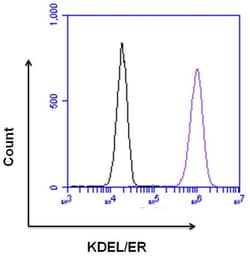Learn More
Invitrogen™ KDEL Polyclonal Antibody
Rabbit Polyclonal Antibody
Supplier: Invitrogen™ PA1013
Description
PA1-013 detects KDEL from human, rat, mouse and hamster. PA1-013 has been successfully used in Western blot, immunofluorescence and immunoprecipitation procedures. By Western blot, this antibody detects a 57 kDa protein representing protein disulfide isomerase (PDI), a 78 kDa protein representing glucose regulated protein 70 kDa (GRP78) and an ~94 kDa protein representing GRP94 in mouse myeloma cells. Immunofluorescence staining of GRP78 in mouse myeloma cells with PA1-013 results in diffuse cytoplasmic staining consistent with specific ER localization. PA1-013 immunoprecipitates PDI, GRP78, an ~72 kDa protein which may be endoplasmic reticulum protein 72 kDa (ERp72), and an ~94 kDa protein representing GRP94 from numerous rodent tissues. The PA1-013 immunogen is a synthetic peptide corresponding to residues C T(643) G E E D T S E K D E L(654) of rat GRP94. Reconstitute in 100 μL PBS to create a stock of 1 mg/mL.
The sequence Lys-Asp-Glu-Leu (KDEL) or a closely related sequence, is present at the carboxy-terminus of soluble endoplasmic reticulum (ER) resident proteins and some membrane proteins. 78 and 94 kDa glucose regulated proteins, GRP78 and GRP94 respectively, and protein disulfide isomerase (PDI) all share the C-terminal KDEL sequence. The presence of carboxy-terminal KDEL appears to be necessary for ER retention and appears to be sufficient to reduce the secretion of proteins from the ER. This retention is reported to be mediated by a KDEL receptor.
Specifications
| KDEL | |
| Polyclonal | |
| Unconjugated | |
| HSPA5 | |
| 78 kDa glucose-regulated protein; 8030486F04Rik; 94 kDa glucose-regulated protein; 94 kDa glucose-regulated protein {ECO:0000250; AL022860; AU019543; AW215843; baffled; Binding-immunoglobulin protein; BiP; D2Wsu141e; D2Wsu17e; ECGP; Endoplasmic reticulum chaperone BiP; endoplasmic reticulum lumenal Ca(2+)-binding protein grp78; endoplasmic reticulum resident protein 58; Endoplasmic reticulum resident protein 99; Endoplasmin; endoplasmin {ECO:0000250; endothelial cell (HBMEC) glycoprotein; EP58; epididymis luminal protein 35; epididymis secretory sperm binding protein Li 125m; epididymis secretory sperm binding protein Li 89n; ER lumen protein retaining receptor 1; ER lumen protein-retaining receptor 1; ER protein 58; ERD2; Erd2.1; ERp58; ERp99; glucose regulated protein, 78 kDa; glucose-regulated protein; glucose-regulated protein, 78kDa; gp96; gp96 homolog; GRP 78; Grp78; GRP-78; GRP94; GRP-94; HDEL; heat shock 70 kDa protein 5; heat shock 70kD protein 5; heat shock 70kD protein 5 (glucose-regulated protein, 78kD); heat shock 70kDa protein 5 (glucose-regulated protein); heat shock 70kDa protein 5 (glucose-regulated protein, 78kDa); heat shock protein 5; Heat shock protein 70 family protein 5; heat shock protein 90 beta family member 1; heat shock protein 90 kDa beta member 1; heat shock protein 90 kDa beta member 1 {ECO:0000250; heat shock protein 90, beta (Grp94), member 1; heat shock protein 90, beta, member 1; heat shock protein 90kDa beta (Grp94), member 1; heat shock protein 90kDa beta family member 1; heat shock protein family A (Hsp70) member 5; Heat shock protein family A member 5; HEL35; HEL-S-125m; HEL-S-89n; Hsce70; HSP70 family protein 5; Hsp90b1; hsp90b1 {ECO:0000250; HSPA5; I79_019946; I79_020931; Immunoglobulin heavy chain-binding protein; KDEL; KDEL (Lys-Asp-Glu-Leu) containing 1; KDEL (Lys-Asp-Glu-Leu) endoplasmic reticulum protein retention receptor 1; KDEL endoplasmic reticulum protein retention receptor 1; KDEL motif containing 1; KDEL motif-containing 1; KDEL motif-containing protein 1; KDEL receptor 1; KDEL1; KDELC1; KDELR1; Lys-Asp-Glu-Leu; mBiP; MIF2; PM23; POGLUT2; Polymorphic tumor rejection antigen 1; Protein O-glucosyltransferase 2; Protein O-xylosyltransferase POGLUT2; Putative MAPK-activating protein PM23; RP23-446N16.1; Sez7; SEZ-7; Steroidogenesis-activator polypeptide; stress-inducible tumor rejection antigen gp96; TA-3; Targ2; Tra1; Tra-1; transforming growth factor alpha regulated gene 2; tumor rejection antigen (gp96) 1; tumor rejection antigen 1; Tumor rejection antigen gp96; UniProtKB:P08113}; UNQ1910/PRO4357; XAP-1 antigen | |
| Rabbit | |
| Antigen affinity chromatography | |
| RUO | |
| 100689305, 100750912, 100773331, 10945, 14828, 22027, 25617, 3309, 361577, 362862, 68137, 7184 | |
| -20°C, Avoid Freeze/Thaw Cycles | |
| Lyophilized |
| Flow Cytometry, Immunohistochemistry (Paraffin), Immunoprecipitation, Western Blot, Immunocytochemistry | |
| 1 mg/mL | |
| PBS with no preservative | |
| P06761, P08113, P11021, P14625, P20029, P24390, Q569A6, Q66HD0, Q99JH8 | |
| Hsp90b1, HSPA5, Kdelr1 | |
| Synthetic peptide corresponding to residues C T(643) G E E D T S E K D E L(654) of rat GRP94. | |
| 100 μg | |
| Primary | |
| Human, Mouse, Rat, Hamster | |
| Antibody | |
| IgG |
Safety and Handling
Your input is important to us. Please complete this form to provide feedback related to the content on this product.




